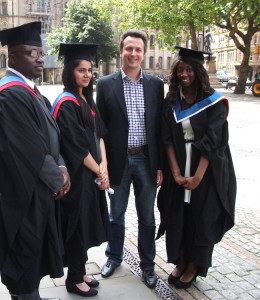What personal learning experiences have influenced
my thoughts about teaching?
 I went to do my CertEd in 2004 at the University of London, while doing PhD in Computer Science. By that time, I have already been teaching for approximately 7 years. I have had quite rich experience of teaching at different institutions, in different countries, in different languages, and different programming languages. Technologies changed significantly during those years, so I had to adapt and learn in line with the rhythm of the life. So my question was – what could I possibly learn that would help me teach?
I went to do my CertEd in 2004 at the University of London, while doing PhD in Computer Science. By that time, I have already been teaching for approximately 7 years. I have had quite rich experience of teaching at different institutions, in different countries, in different languages, and different programming languages. Technologies changed significantly during those years, so I had to adapt and learn in line with the rhythm of the life. So my question was – what could I possibly learn that would help me teach?
How do I learn?
 And then I discovered learning styles. Keefe (1979) defines learning styles as the “composite of characteristic cognitive, affective, and physiological factors that serve as relatively stable indicators of how a learner perceives, interacts with, and responds to the learning environment”. Stewart and Felicetti (1992) define learning styles as those “educational conditions under which a student is most likely to learn.” I have read further on this topic and have found out that there are four major, or rather, most commonly used learning styles. These are: visual, aural, read-write and kinaethetic, also known as tactile (though tactile is sometimes separated from kinaethetic type). Each one of these styles is different from another in a very distinct and clear way. For example, visual learners need to see the teacher’s body language and facial expression to fully understand the content of a lesson. They tend to prefer sitting at the front of the classroom to avoid visual obstructions (e.g. people’s heads). They may think in pictures and learn best from visual displays including: diagrams, illustrated textbooks, overhead transparencies, videos, flipcharts and handouts. During a lecture or classroom discussion, visual learners often prefer to take detailed notes to absorb the information. Auditory (aural) learners, in contrast, learn best through verbal lectures, discussions, talking things through and listening to what others have to say. Auditory learners interpret the underlying meanings of speech through listening to tone of voice, pitch, speed and other nuances. For them, written information may have little meaning until it is heard. These learners often benefit from reading text aloud and using a tape recorder (online resource). Once the teacher becomes aware of the differences in learners preferred learning styles, he or she becomes capable of adjusting his/her own teaching in such a way so that it reflects on and goes in line with his or her learners’ learning preferences.
And then I discovered learning styles. Keefe (1979) defines learning styles as the “composite of characteristic cognitive, affective, and physiological factors that serve as relatively stable indicators of how a learner perceives, interacts with, and responds to the learning environment”. Stewart and Felicetti (1992) define learning styles as those “educational conditions under which a student is most likely to learn.” I have read further on this topic and have found out that there are four major, or rather, most commonly used learning styles. These are: visual, aural, read-write and kinaethetic, also known as tactile (though tactile is sometimes separated from kinaethetic type). Each one of these styles is different from another in a very distinct and clear way. For example, visual learners need to see the teacher’s body language and facial expression to fully understand the content of a lesson. They tend to prefer sitting at the front of the classroom to avoid visual obstructions (e.g. people’s heads). They may think in pictures and learn best from visual displays including: diagrams, illustrated textbooks, overhead transparencies, videos, flipcharts and handouts. During a lecture or classroom discussion, visual learners often prefer to take detailed notes to absorb the information. Auditory (aural) learners, in contrast, learn best through verbal lectures, discussions, talking things through and listening to what others have to say. Auditory learners interpret the underlying meanings of speech through listening to tone of voice, pitch, speed and other nuances. For them, written information may have little meaning until it is heard. These learners often benefit from reading text aloud and using a tape recorder (online resource). Once the teacher becomes aware of the differences in learners preferred learning styles, he or she becomes capable of adjusting his/her own teaching in such a way so that it reflects on and goes in line with his or her learners’ learning preferences.
Indeed, research has demonstrated that students’ progress was negatively affected by an instructional approach, which was not consistent with students’ beliefs about the best way for them to learn (Yorio, 1986). Having familiarised myself with a variety of learning styles, made two things very clear to me. Firstly, that I am a visual learner, as I always draw diagrams and sketches. And secondly, and most importantly, that not everybody in my classroom is a visual learner, and therefore my nice and clear diagrams may not necessarily make as much sense to my learners as I have initially assumed. And I am not talking about “Robert and Susan problem” (Biggs and Tang, 2007), where a student – let’s say, Robert – is disinterested and unengaged. I am talking about student who is genuinely interested in the subject and yet does not understand “my beautiful diagram”. Because he needs the same information presented in different way! Maybe, he is good in getting hands-on experience, like all kinaethetic learners are? Since then, my knowledge on learning styles has informed my teaching a lot and I always bear it in mind when I prepare my sessions for every new group of learners. Thus, for example, I have started presenting the same material in different ways, including reading it aloud – even if it is written on the board, addressing in such a way UKPSF’s V1 objective “Respect individual learners and diverse learning communities”. Though, this objective can obviously be interpreted wider in a sense of respecting and recognising needs of learners with, say, physical disabilities, or talented and gifted learners, or learners with young families, or learners from refugees families (very often these are the learners from families without any, or very little, experience of higher education, understanding or recognition of its values).
How do my students learn?
 Over the years of teaching I have also learned that learners not only have different learning styles but also different learning preferences, or ways in which they learn best. I have noticed that some of my learners perform best when they work in a small group environment, where students can help each other and task outcome is a collective effort, whereas other learners perform their best when they work on their own and take full and complete responsibility of the outcome on their shoulders. These two types of learning preferences are often referred to as field-dependent and field-independent, respectively (Witkin et al, 1977). I have also noticed that some of my learners are very shy and feel very uneasy when they are nominated for an answer but are not sure whether their response, or line of thinking, is correct; whereas other students seem to be always eager to try their ideas out regardless of how correct or ‘incorrect’ they might be. These two phenomena are known in the literature as ‘reflective’ and ‘impulsive’ learners, respectively (Smith, 2004). I refer myself to the group of impulsive learners who are always keen to share and try out ideas as they pop into the head even though they may still be ‘in the process of making’ and may end up being rejected as misleading (but may well be accepted as valid ones!!). But as a teacher I always remember to address needs of my ‘reflective’ learners and give them extra time to think over their answer (reflect on it, make sure they are happy with it as well as with the arguments that they are going to develop to support their response) before they are invited to share it with the rest of the class. By doing this I fulfil UKPSF’s K2 objective which states that lectures working in HE should have knowledge on “How students learn, both generally and within their subject/disciplinary area(s)”.
Over the years of teaching I have also learned that learners not only have different learning styles but also different learning preferences, or ways in which they learn best. I have noticed that some of my learners perform best when they work in a small group environment, where students can help each other and task outcome is a collective effort, whereas other learners perform their best when they work on their own and take full and complete responsibility of the outcome on their shoulders. These two types of learning preferences are often referred to as field-dependent and field-independent, respectively (Witkin et al, 1977). I have also noticed that some of my learners are very shy and feel very uneasy when they are nominated for an answer but are not sure whether their response, or line of thinking, is correct; whereas other students seem to be always eager to try their ideas out regardless of how correct or ‘incorrect’ they might be. These two phenomena are known in the literature as ‘reflective’ and ‘impulsive’ learners, respectively (Smith, 2004). I refer myself to the group of impulsive learners who are always keen to share and try out ideas as they pop into the head even though they may still be ‘in the process of making’ and may end up being rejected as misleading (but may well be accepted as valid ones!!). But as a teacher I always remember to address needs of my ‘reflective’ learners and give them extra time to think over their answer (reflect on it, make sure they are happy with it as well as with the arguments that they are going to develop to support their response) before they are invited to share it with the rest of the class. By doing this I fulfil UKPSF’s K2 objective which states that lectures working in HE should have knowledge on “How students learn, both generally and within their subject/disciplinary area(s)”.
What does teaching and learning mean to me?
In 2005 I was offered job at The Manchester College. Having grown up in a capital, and having spent five years in London, it was a very difficult move to tiny Manchester. However, nothing compares with that feeling, when you wake up in the morning, smile, and drive to the place you like, to do job you love! Teaching is not only my job; it is also my hobby, and it is something I really enjoy and love doing! By teaching I learn. I genuinely believe that a good teacher is not the one who knows a lot but the one who can convey his knowledge to the students in such a way so that they understand it, internalise it and become capable of using it to solve real life tasks. Therefore, as a teacher I constantly learn, learn to be exactly that. And my students… well, my students are the most valuable resource, helping me to become a better teacher. As Ramsden (1992: 21) puts it “teaching and learning in higher education are inextricably and elaborately linked. To teach is to make an assumption about what and how the student learns; therefore, to teach well implies learning about students’ learning. ‘Learning and teaching are constantly interchanging activities. One learns by teaching; one cannot teach except by constantly learning’ (Eble, 1988, p. 9).
What do I want my students to learn?
 I completed my MSc in Computer Science in 2001. 40 hours a week of class contact, plus the same amount of home study – all of this for 6 years. About 8 exams every year. What is the result? Information Technologies (and programming in particular) have developed significantly since then, so none of the technologies I learned at University are still alive. Was that time wasted then? Not really.
I completed my MSc in Computer Science in 2001. 40 hours a week of class contact, plus the same amount of home study – all of this for 6 years. About 8 exams every year. What is the result? Information Technologies (and programming in particular) have developed significantly since then, so none of the technologies I learned at University are still alive. Was that time wasted then? Not really.
 That is what I am trying to explain to my students: one of ultimate purposes of HE course is to teach you how to learn. Not to teach you a particular programming language, technology, or skills. Those will become out of date very soon – maybe, even before you graduate! But if HE course has opened your mind to new things, has shown that there are no boundaries – you will be able to quickly adapt and grasp new things quickly. And that is the ultimate purpose of your education. The very same thing allowed me to successfully navigate throughout 30 different programming languages and technologies in my teaching career.
That is what I am trying to explain to my students: one of ultimate purposes of HE course is to teach you how to learn. Not to teach you a particular programming language, technology, or skills. Those will become out of date very soon – maybe, even before you graduate! But if HE course has opened your mind to new things, has shown that there are no boundaries – you will be able to quickly adapt and grasp new things quickly. And that is the ultimate purpose of your education. The very same thing allowed me to successfully navigate throughout 30 different programming languages and technologies in my teaching career.
Another ultimate purpose of HE Course it to make it clear to the students that what they are learning they are learning with a purpose, and this purpose being not memorising the course material but being able to use it in practical ways in solving real life tasks. Students study not to pass exams, they study to become successful professionals capable of solving challenging tasks using their knowledge (as transferred to them by the teacher during the course) and intelligence (as developed during the course via practical tasks and challenging activities; as well as via independent, out of class, learning). This point reinforces K1 and V4 objectives from UKPSF, namely: Delivering the ‘core knowledge’ by presenting “The subject material” and “Acknowledging the wider context in which higher education operates recognising the implications for professional practice”, respectively.
 What do I love about teaching?
What do I love about teaching?
Well, what is teaching first of all? Guiding. Helping. Revealing. Let it be. I love it all! But for me, teaching is first of all – Passion. If you can make students feel passionate about your subject in the same way that you are, they are a hundred times more likely to enjoy your classes and learn from them. However Bligh (1972), on the basis of his review of 100 research studies, warns that “lectures are [only] relatively effective for presenting information, but unsupervised reading is more effective” and that “lectures are quite ineffective for stimulating higher order thinking”. I agree with the author’s second claim. Indeed students develop their higher order thinking skills way better when they have an opportunity to get actively engaged with the subject, for example during group work activities or open discussion facilitated by the teacher, rather then when they have to passively perceive information transferred to them during the lecture. I however, do not fully agree with Bligh on his first claim. In my experience, students tend to either not do unsupervised reading at all or do it very briefly without necessarily making desired sense of it. What is important here, I believe, is that students are not asked to do unsupervised reading alone, but are also asked to do some tasks based on it, which are later included into classroom activities as part of seminar sessions. We need to remember that students need to be kept motivated all the way through, whatever they do in their learning. Even highly motivated learners, intrinsically motivated ones, like Susan (Biggs and Tang, 2007: 36), can eventually give up if their efforts and achievements are not recognised or reinforced. Not to mention extrinsically motivated learners who often need encouragement, continuous monitoring and scaffolding of their learning and progress all the way through the course via manageable tasks and positive feedback.
In my classes, I try to address both groups of learners, differentiating levels of my tasks, instruction, assessment and feedback according to the students’ needs, a point reinforced in UKPSF objectives A2, A3 and A4 – “Teach and/or support learning”, “Assess and give feedback to learners” and “Develop effective learning environments and approaches to student support and guidance”, respectively.
What are my strengths as a teacher?
While learning English as a second language I have experienced use of PPP approach in my language classes. In SLA (second language acquisition) literature this approach is known as “Presentation. Practice. Production” (Skehan, 1996). This pedagogical approach is characterised by teacher firstly presenting information to the learners (like, a lecture), then giving them an opportunity to practice new material in a restricted environment (like, completing short tasks focusing specifically and narrowly on the features presented during Presentation/Lecture stage), and finally producing features of language presented in less restricted and more open ended tasks by the end of the lesson. This approached worked really well for me then. The teacher was able to cover all material and we had opportunities to practice it in the classroom. I doubt, however, that I could use this approach with my IT students and the reason for this is that in the field of my subject amount of theoretical material is vast and endless. It is simply impossibly physically to explain every single statement and function. The only way to go is to explain the basics, so that students are able to create simplest programs. Well, doing this equips my students with basic skills of ‘artificial’ programming which is good enough for the classroom task only. But what about ‘real life’ tasks, real computer programs that they will have to develop as part of their future professional practice? This is where Problem Based Learning (PBL) (Jochems et al., 2004) comes very handy and this is where, I believe, my strength as a teacher lies. When teaching, I always find balance between amounts of material that I can effectively present and explain during my sessions and amounts of material that I want my students to self-study while completing problem based tasks that I set up for them. These tasks are often parts not only of seminar sessions but also of course assessment. I like the way Thomas Carruthers puts it: “A teacher is one who makes himself progressively unnecessary [in his classroom]” (Quote). By the end of the course I aim to be exactly that for my students, so that they are independent and capable of solving problems without my assistance. By employing PBL as part of my teaching repertoire I address A4 descriptor from UKPSF, namely “Develop effective learning environments and approaches to student support and guidance”.
What areas do I need to develop further?
 Looking critically at my own teaching, I feel that I conduct it to quite a high standard from practical perspective. I however feel that my knowledge of research and theory in the filed of pedagogical methodologies is somewhat limited to date. Clearly, there are interesting research results, and theoretical findings out there in research journals and books that explain and justify mechanisms behind PBL type of teaching and learning, for example. This is the area which I would like to develop, and which is directly linked to UKPSF descriptors A5 and V3: “Engage in continuing professional development in subjects/disciplines and their pedagogy, incorporating research, scholarship and the evaluation of professional practices, and “Use evidence-informed approaches and the outcomes from research, scholarship and continuing professional development” to inform teaching and learning.
Looking critically at my own teaching, I feel that I conduct it to quite a high standard from practical perspective. I however feel that my knowledge of research and theory in the filed of pedagogical methodologies is somewhat limited to date. Clearly, there are interesting research results, and theoretical findings out there in research journals and books that explain and justify mechanisms behind PBL type of teaching and learning, for example. This is the area which I would like to develop, and which is directly linked to UKPSF descriptors A5 and V3: “Engage in continuing professional development in subjects/disciplines and their pedagogy, incorporating research, scholarship and the evaluation of professional practices, and “Use evidence-informed approaches and the outcomes from research, scholarship and continuing professional development” to inform teaching and learning.
masterofsql
Word count: 2495
3th January 2013
.
References
Biggs, J. and Tang, C. (2007) Teaching for Quality Learning at University (3rd edition). Berkshire, England: Open University Press / McGraw-Hill Education.
Eble, K.E. (1988) The Craft of Teaching (2nd edition), San Francisco: Jossey-Bass.
Fleming, N.D. and Mills, C. (1992) Not Another Inventory, Rather a Catalyst for Reflection. To Improve the Academy, Vol. 11, 1992., page 137.
Higher Education Academy, 2012. Problem Based Learning. [online] Available at <http://www.heacademy.ac.uk/cebe/themes/pbl> [Accessed 17 Nov 2012].
Fleming, N.D. 2001. VARK® – a guide to learning styles. [online] Available at <http://www.vark-learn.com/english/index.asp> [Accessed 16 Nov 2012].
McLeod, S. (2010) Kolb – Learning Styles Inventory. [online] Available at <http://www.simplypsychology.org/learning-kolb.html> [Accessed 16 Nov 2012].
Learning Styles Explained [online] Available at <http://www.ldpride.net/learningstyles.MI.htm> [Accessed 16 Nov 2012]
Jochems, W., van Merri‘nboer, J., and Koper, R. (2004) Integrated E-Learning: Implications for Pedagogy, Technology and Organisations. London: Routledge Falmer.
Keefe, J. W. (1979) Learning style: An overview. NASSP’s Student learning styles: Diagnosing and proscribing programs (pp. 1-17). Reston, VA: National Association of Secondary School Principles.
Ramsden, P. (1992) Learning to Teach in Higher Education. London: Routledge.
Skehan, P. (1996) Second language acquisition research and task-based instruction. In Willis, J. and Willis, D. (Eds) Challenge and Change in Language Teaching. Heinemann.
Smith, C.R. (2004) Learning Disabilities: The Interaction of Students and their Environments. London: Pearson. pp. 105-112.
Stewart, K. L., and Felicetti, L. A. (1992). Learning styles of marketing majors. Educational Research Quarterly, 15(2), 15-23.
Ilene Dawn, A. (2012) Learning and Teaching Philosophy? What Are Your Essential Messages? [online] Available at <http://uminntilt.wordpress.com/2012/09/03/learning-and-teaching-philosophy-got-one-you-openly-share-with-your-students/> [Accessed 17 Nov 2012].
Carruthers, T. Quote <http://www.oocities.org/findhershey/english/quotations_about_teachers.htm>
Witkin, H.A., Moore, C.A., Goodenough, D.R. and Cox, P.W. (1977) Field-Dependent and Field-Independent Cognitive Styles and Their Educational Implications. Review of Educational Research, 47(1), pp.1-64.
Yorio, C. 1986: Consumerism in Second Language Learning and Teaching. Canadian Modern Language Review, 42/3: 668-687.
The Higher Education Academy, 2012. UK Professional Standards Framework (UKPSF). [online] Available at: <http://www.heacademy.ac.uk/ukpsf> [Accessed 17 November 2012].


